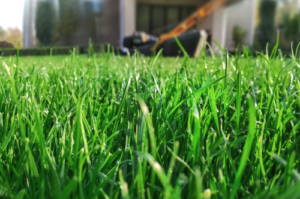
With the water restrictions currently in place in Calgary due to pipe repair and the heat wave that we are currently going through in Alberta, you may be wondering if there is any way to make your lawn more drought resistant and the answer is yes.
Making a lawn more drought-resistant involves several strategies that focus on proper lawn care practices, soil health, and grass selection.
Following are some effective methods to make your lawn more drought resistant:
Strategies to Make Your Lawn More Drought Resistant
1. Mowing Practices:
Mow High: Set your mower blades higher to leave grass taller. Taller grass shades the soil, reduces evaporation, and encourages deeper root growth.

Mow Regularly: Regular mowing helps maintain grass health, but avoid cutting more than one-third of the grass height at a time.
2. Watering Practices:
Deep and Infrequent Watering: Water your lawn deeply but less frequently. This encourages roots to grow deeper, making the lawn more resilient to drought.
Early Morning Watering: Water in the early morning to minimize evaporation and allow the grass to absorb water more efficiently.
Avoid Overwatering: Overwatering can lead to shallow root growth and increased susceptibility to drought.
3. Proper Lawn Care Practices:
Avoid Heavy Traffic: Minimize foot traffic on the lawn during drought periods to reduce stress on the grass.
Dethatching: Remove excessive thatch build-up to improve water infiltration and root growth.
4. Fertilization:
Balanced Fertilizer: Use a balanced, slow-release fertilizer to provide essential nutrients without promoting excessive, shallow root growth.
Avoid Over-Fertilizing: Too much fertilizer can lead to rapid, weak growth that is less drought-tolerant.
5. Weed Control:
Healthy Lawn: Maintain a healthy lawn to reduce weed competition. Weeds often compete with grass for water, so a thick, healthy lawn can crowd out weeds.
Manual Removal: Remove weeds manually or use targeted herbicides if necessary, ensuring they do not damage the grass.
6. Improve Soil Health:
Aeration: Aerate your lawn to reduce soil compaction and improve water infiltration. This helps roots grow deeper and access moisture from a larger soil volume.
Organic Matter: Incorporate organic matter, such as compost, into the soil to improve its structure, water-holding capacity, and nutrient content.
pH Balance: Test and adjust the soil pH to ensure optimal nutrient availability for your grass.
7. Mulching:
Grass Clippings: Leave grass clippings on the lawn as mulch to help retain moisture and provide organic nutrients as they decompose.

Mulch Beds: Use mulch around trees and shrubs to retain soil moisture and reduce competition for water.
8. Choose the Right Grass Type:
Drought-Resistant Grass Varieties: Select grass species known for their drought tolerance. Examples include Kentucky bluegrass, fine fescue, and tall fescue. These grasses have deeper root systems that can access water from deeper soil layers.
Native Grasses: Consider using native grass species that are well-adapted to local climate conditions.
By following these practices, you can develop a lawn that is more resilient to drought conditions and better equipped to thrive during periods of limited water availability.
Please contact us if you have any questions. We offer weed control, lawn fertilizer, weekly and biweekly mowing, core aeration, and overseeding services in Calgary, Red Deer and close surrounding communities.


Recent Comments